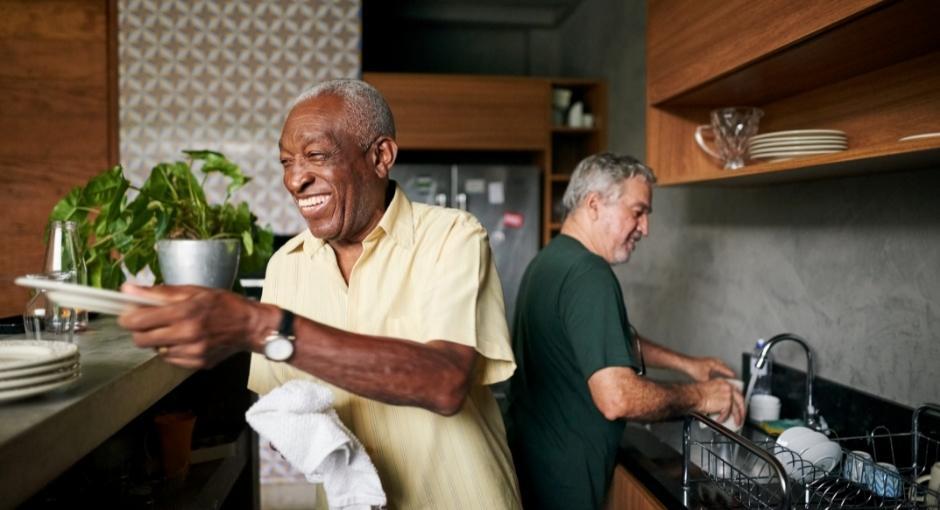Practical Pointers

Navigating Parkinson’s disease (PD) can come with many surprises. As a care partner, it takes skill and patience to know when to assist with a task and when to simply allow the person more time to complete the task independently.
Below we highlight tips and strategies you can use to make the most of each day.
Managing Day-to-Day Challenges
Simple, routine tasks can become more challenging as Parkinson’s progresses. The following changes can make daily life around the home easier to perform:
- Relocate frequently used items in the kitchen, bedroom and bathroom to a place where they can be readily accessed.
- Label drawers and cabinets to easily identify contents.
- Simplify hygiene tasks with electric toothbrushes and shavers. Read more Bathing & Grooming tips.
- Substitute Velcro closures for buttons on shirt cuffs, waistbands and other clothing that is hard to fasten. Some shoes also use Velcro!
- Make mealtime easier with assistive technology and devices like covered cups, rocker knives, large-handled utensils and plate guards.
- Seek a referral to an occupational therapist for individualized evaluation and recommendations tailored to your loved one’s needs and concerns.
Cueing Strategies
Parkinson’s disease impacts the ability to perform movements that are usually done without conscious thought. As the disease progresses, your loved one’s movements will become smaller and less automatic. Parkinson’s can also result in an inaccurate perception of movement, size, and quality, so your loved one may not fully recognize these changes. Using cues can help your loved one move more easily.
Simple cues can make the brain less dependent on its automatic systems and “reroute” messages, so movement improves. Keep it short. Long explanations or instructions are often harder to follow for someone with Parkinson’s.
Movement cues can include:
- “Stand tall” if posture becomes too flexed
- “Big steps” to decrease shuffling when walking
- “March” when turning to keep knees high
Since Parkinson’s impacts automatic movements, standing tall and taking big steps, for example, may not happen automatically. You will likely need to repeat cues on a regular basis.
Ask the doctor for a referral to a physical therapist who can tailor cueing strategies to your loved one’s individual needs. There are many ways to help with walking challenges, such as freezing episodes.
Freezing
Many people with mid-stage to advanced Parkinson’s disease experience “freezing.” Not all people with PD experience freezing episodes, but those who do have a greater risk of falling.
Freezing is the temporary, involuntary inability to move.
During a freezing episode, a person with PD may feel like their feet are stuck in place, or it may be difficult to get up from a chair. Freezing may also affect other parts of the body or speech. Sometimes freezing episodes occur around certain triggers.
How to Help During a Freezing Episode
Communication
Parkinson’s can impact communication in many ways. Most people with Parkinson’s experience a soft voice, and may be difficult to hear. Loss of automatic facial expression can be misinterpreted as boredom, anger or sadness. Mood changes in Parkinson’s such as apathy, depression or anxiety can also affect communication. The following tips can make communication easier.
- Try to have conversations one-on-one or in small groups. Smaller groups will be more willing to pause the conversation and wait for a comment, compared to a large group.
- Reduce or remove distractions like TV, radio or music when speaking to the person with Parkinson’s.
- Be close to each other when you talk so it is easier to hear. Avoid yelling from another room in the house!
- Encourage your loved one to take a deep breath before beginning to speak to enhance his or her vocal loudness.
- Give your loved one time to respond or participate in the conversation. Just like slowness in movement, thought processes can be slowed by Parkinson’s disease.
- Do not make assumptions about how your loved one is feeling based on facial expressions. Remember, you can’t judge a book by its cover!
- Seek a referral to a speech pathologist who is certified in the Lee Silverman Voice Treatment therapy, trained in the Parkinson Voice Project SPEAK OUT! program or has trained experience in Parkinson’s care.
Coping with Tiredness and Fatigue
Many people with Parkinson’s report a loss of energy and chronic fatigue, which may be disruptive to planned activities and schedules. While sleep and fatigue are related, they aren’t the same.
Fatigue is a feeling of being extremely tired, sometimes described of being either physically or mentally weary. Most people talk about fatigue as a result of some type of exertion — being tired from working or from thinking — but sometimes it is there all the time.
Fatigue is different from sleepiness. When you’re sleepy, you want to fall asleep and can do so easily. No matter how extreme, fatigue does not usually result in sleep, even in sedentary situations.
Parkinson’s & Sleep
Sleep-related symptoms are reported by more than 75% of people with PD. Explore this intrusive symptom’s most common issues and tips for getting better sleep with Parkinson’s.
If your loved one is fatigued, try the following when planning your day:
- Adjust your schedule. It may be helpful to schedule fewer activities each day. Your loved one may not be able to do as much as they used to do because of their changing energy levels. You can also consider breaking up tasks, errands or other activities into shorter time periods.
- Prioritize rest. Schedule brief rest periods or naps to restore your loved one’s energy during the day. This is especially important while traveling. Travel schedules should include enough time to accommodate rest periods.
- Stay flexible. Your schedule may need to adjust in response to your loved one’s energy levels. You may need to postpone or cancel activities based on these variations. It can help to have a back-up plan in case the scheduled activity falls through or becomes unsafe.
- Follow their lead. Your loved one with Parkinson’s need more assistance when feeling fatigued. Offer help as needed but allow them to do what they have the energy to (safely) do. Remember to encourage your loved one to avoid tasks that require significant coordination or attention when tired to avoid accidents or falls.
Care Partner Course: "Role of Sleep"
Learn more about how sleep and fatigue impact both your loved one and you in this free care partner course. Take it at your own pace, any time!
Keeping Your Loved One Safe
As a care partner, it can be difficult to recognize changes that occur in your loved one over time. If Parkinson’s symptoms begin to significantly affect mobility, memory or thinking skills, it may be time to consider if it is still safe for your loved one to perform tasks that he or she once did easily as part of the daily routine.
While each person experiences Parkinson’s differently, it is important to know that even familiar tasks can become difficult or unsafe. Making these changes can be complicated. Acknowledge these losses and offer support as needed.
Driving
Loss of flexibility in the neck and trunk, reduced reaction time and changes in ability to multi-task may affect your loved one’s driving safety. Though it may be difficult to broach this topic, it is important to be realistic and seek medical advice and input if you notice changes. Occupational therapists are often involved in performing objective driving assessments and can offer recommendations. Learn more about Parkinson’s and driving.
Use of Power Tools
Tremor combined with balance and coordination changes can impact safe use of power tools, even if the person with Parkinson’s has used them for a long time. Slowed reaction time can also add to safety concerns. Consider all these factors when helping the person with Parkinson’s determine if using power tools continues to be safe.
Kitchen Appliances
Cooking is often a multi-step process, and a person with Parkinson’s may begin to have difficulty managing kitchen tasks safely. Balance changes can make opening refrigerator and oven doors difficult, and falls can occur when attempting to reach high shelves or carry objects from counter to table.
Climbing
Balance issues and loss of automatic reflexes increase the risk of falls in people with PD. Climbing on ladders, step stools or other apparatus should be avoided.
Creating a Safe Home Environment
Even if your loved one has lived in their home for a long time, it may be hard for them stay safe due to changes in movement, balance, vision or thinking. Changes may be necessary for current and future needs.
We know that keeping your loved one safe at home is a priority. Make changes where you can and don’t be afraid to bring in an occupational therapist to help assess where adjustments can be made.

Home Safety
Adapting your home to create a safer environment can lower the risk of Parkinson’s-related injuries and keep you aging in place. We highlight practical tips that you can make in every area of your home.
Suggestions and tips for helping your loved one manage advanced PD should always be modified to best suit both of your needs. We strongly recommend building a care team in your local area to help you on your caregiving journey. For referrals, talk to your loved one’s PD doctor or call our Helpline at 1-800-4PD-INFO (1-800-473-4636).